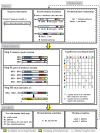Reconstituting protein interaction networks using parameter-dependent domain-domain interactions
- PMID: 23651452
- PMCID: PMC3660195
- DOI: 10.1186/1471-2105-14-154
Reconstituting protein interaction networks using parameter-dependent domain-domain interactions
Abstract
Background: We can describe protein-protein interactions (PPIs) as sets of distinct domain-domain interactions (DDIs) that mediate the physical interactions between proteins. Experimental data confirm that DDIs are more consistent than their corresponding PPIs, lending support to the notion that analyses of DDIs may improve our understanding of PPIs and lead to further insights into cellular function, disease, and evolution. However, currently available experimental DDI data cover only a small fraction of all existing PPIs and, in the absence of structural data, determining which particular DDI mediates any given PPI is a challenge.
Results: We present two contributions to the field of domain interaction analysis. First, we introduce a novel computational strategy to merge domain annotation data from multiple databases. We show that when we merged yeast domain annotations from six annotation databases we increased the average number of domains per protein from 1.05 to 2.44, bringing it closer to the estimated average value of 3. Second, we introduce a novel computational method, parameter-dependent DDI selection (PADDS), which, given a set of PPIs, extracts a small set of domain pairs that can reconstruct the original set of protein interactions, while attempting to minimize false positives. Based on a set of PPIs from multiple organisms, our method extracted 27% more experimentally detected DDIs than existing computational approaches.
Conclusions: We have provided a method to merge domain annotation data from multiple sources, ensuring large and consistent domain annotation for any given organism. Moreover, we provided a method to extract a small set of DDIs from the underlying set of PPIs and we showed that, in contrast to existing approaches, our method was not biased towards DDIs with low or high occurrence counts. Finally, we used these two methods to highlight the influence of the underlying annotation density on the characteristics of extracted DDIs. Although increased annotations greatly expanded the possible DDIs, the lack of knowledge of the true biological false positive interactions still prevents an unambiguous assignment of domain interactions responsible for all protein network interactions.Executable files and examples are given at: http://www.bhsai.org/downloads/padds/
Figures





Similar articles
-
GAIA: a gram-based interaction analysis tool--an approach for identifying interacting domains in yeast.BMC Bioinformatics. 2009 Jan 30;10 Suppl 1(Suppl 1):S60. doi: 10.1186/1471-2105-10-S1-S60. BMC Bioinformatics. 2009. PMID: 19208164 Free PMC article.
-
PPIDomainMiner: Inferring domain-domain interactions from multiple sources of protein-protein interactions.PLoS Comput Biol. 2021 Aug 9;17(8):e1008844. doi: 10.1371/journal.pcbi.1008844. eCollection 2021 Aug. PLoS Comput Biol. 2021. PMID: 34370723 Free PMC article.
-
Knowledge-guided inference of domain-domain interactions from incomplete protein-protein interaction networks.Bioinformatics. 2009 Oct 1;25(19):2492-9. doi: 10.1093/bioinformatics/btp480. Epub 2009 Aug 10. Bioinformatics. 2009. PMID: 19667081 Free PMC article.
-
Evaluation of different domain-based methods in protein interaction prediction.Biochem Biophys Res Commun. 2009 Dec 18;390(3):357-62. doi: 10.1016/j.bbrc.2009.09.130. Epub 2009 Oct 2. Biochem Biophys Res Commun. 2009. PMID: 19800868 Review.
-
Prediction of Protein-Protein Interactions by Evidence Combining Methods.Int J Mol Sci. 2016 Nov 22;17(11):1946. doi: 10.3390/ijms17111946. Int J Mol Sci. 2016. PMID: 27879651 Free PMC article. Review.
Cited by
-
Protein-protein interaction detection: methods and analysis.Int J Proteomics. 2014;2014:147648. doi: 10.1155/2014/147648. Epub 2014 Feb 17. Int J Proteomics. 2014. PMID: 24693427 Free PMC article. Review.
-
Building Bridges Between Structural and Network-Based Systems Biology.Mol Biotechnol. 2019 Mar;61(3):221-229. doi: 10.1007/s12033-018-0146-8. Mol Biotechnol. 2019. PMID: 30656572 Review.
-
ChiPPI: a novel method for mapping chimeric protein-protein interactions uncovers selection principles of protein fusion events in cancer.Nucleic Acids Res. 2017 Jul 7;45(12):7094-7105. doi: 10.1093/nar/gkx423. Nucleic Acids Res. 2017. PMID: 28549153 Free PMC article.
-
Prediction of interactions between viral and host proteins using supervised machine learning methods.PLoS One. 2014 Nov 6;9(11):e112034. doi: 10.1371/journal.pone.0112034. eCollection 2014. PLoS One. 2014. PMID: 25375323 Free PMC article.
-
Prediction of Intra-Species Protein-Protein Interactions in Enteropathogens Facilitating Systems Biology Study.PLoS One. 2015 Dec 30;10(12):e0145648. doi: 10.1371/journal.pone.0145648. eCollection 2015. PLoS One. 2015. PMID: 26717407 Free PMC article.
References
-
- von Mering C, Krause R, Snel B, Cornell M, Oliver SG, Fields S, Bork P. Comparative assessment of large-scale data sets of protein-protein interactions. Nature. 2002;417(6887):399–403. - PubMed
Publication types
MeSH terms
Substances
LinkOut - more resources
Full Text Sources
Other Literature Sources
Molecular Biology Databases

